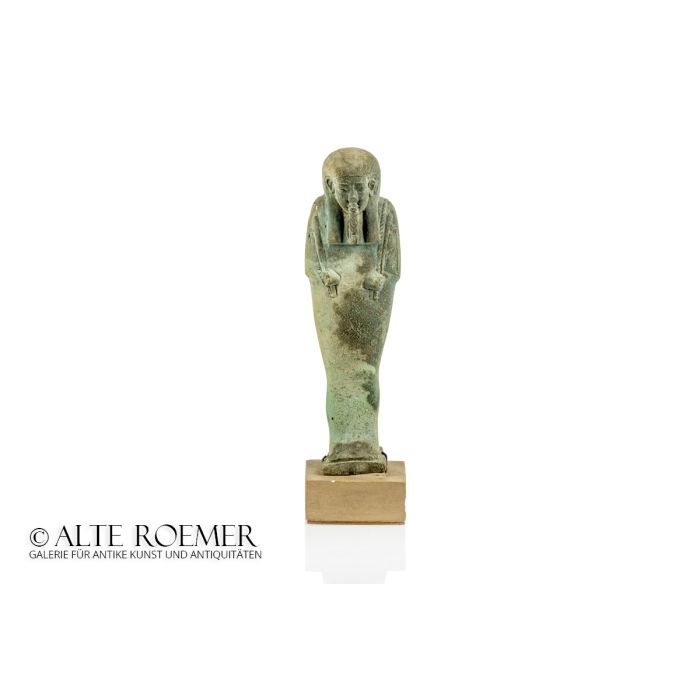Egyptian ushabti for Pa-di-pepet
Price: on request
Sold
Object number
AR3252
| Object: |
Egyptian ushabti for Pa-di-pepet
|
| Material: |
Mint green faience.
|
| Period: |
Circa 664 BC to 595 BC. 26th dynasty, during the reign of Pharaoh Psamtik I or his successor Necho II. Late Period of Ancient Egypt. |
| Description: |
Egyptian funerary statuette with a mummy shaped body. It is one of the ushabtis made for Pa-di-pepet. The statuette has a back pillar and rests on a small base plate. Wearing a tripartite wig with visible ears, attached beard. The arms are crossed in front of the chest, holding an agricultural implement in each hand, a seed basket on the back of the left shoulder. The front and sides of the body are plain. The back pillar is inscribed with engraved hieroglyphs arranged in two columns and separated by a vertical line. The text reads: O this ushabti, if the Osiris, Pa-di-Pepet, born to Bastet-Ir-dis is called upon, "here I am" you shall anwer. It is a short version of the 6th spell of the book of the dead. The figure is of high artistic quality and precisely modelled. |
| Background: |
Little is known about the owner Pa-di-pepet, also spelled Pa-di-pep or Padipepet. No literary sources about his rank and his profession are known. The Egyptologists J.-F. and L. Aubert suggested that Pa-di-pepet lived during the reign of Psamtik I or Necho II, that is, at the beginning of the 26th dynasty. In addition to his ushabtis, his canopic jars have survived the ages. They can be found in the Egyptian Museum in Cairo (inv. no. CG 4266-4269).
|
| Dimensions: |
14.5cm height. 4.2cm width. 16.8cm height including the modern base.
|
| Condition: |
Perfect condition. Absolutely fantastically preserved statuette with razor-sharp legible hieroglyphs on the back. One stable crack at the head, as well as some stable cracks at the back. The shabti is held loosely on the modern base with metal clips. The base is sloped so that the statuette stands upright. Without the modern base, the shabti is also able to stand, but is inclined to one side due to the ancient base plate, which was manufactured at an angle in ancient Egyptian times.
|
| Provenance: |
Acquired by us in 2021 on the German art market. Previously in the German private collection U. H. Acquired at Sotheby's London auction 18 December 1978, lot 273. The tomb of Pa-di-pepet was discovered in 1893 west of the Pyramid of Teti at Saqqara, about 20km south of Cairo. Some of his shabtis ended up in the Egyptian Museum in Cairo and in important museums outside of Egypt. In the years after the find, further of his ushabtis were sold locally to educational travelers and thus ended up in private collections worldwide. This is how the statuette offered here must have reached the art market. |
| References: |
Cf. G. Janes, Shabtis - A Private View (Paris, 2002), pp. 167. Cf. J.-F. und L. Aubert, Statuettes Égyptienne: Chaouabtis, Ouchebtis (Paris, 1974), p. 217. Other ushabtis of this owner can be found e.g. in the following museums: Egyptian Museum Cairo, acc. no. CG 47354-47359. Art Institute of Chicago, ref. no. 1894.228. Eremitage St. Petersburg, no. 18007. |
| Authenticity: |
We unconditionally guarantee the authenticity of every artefact, all items are subject to our lifetime return policy on authenticity.
|


